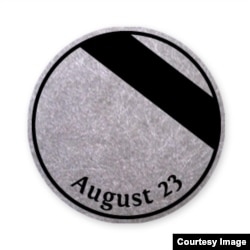Black Ribbon Day, also called the European Day of Remembrance for Victims of Stalinism and Nazism, originated in the 1980s.
Central and Eastern European refugees then living in Canada organized a series of peaceful protests on both sides of the Iron Curtain to draw attention to the rampant human rights abuses perpetrated by authorities across the Soviet bloc.
They chose August 23, the anniversary of the infamous 1939 Molotov-Ribbentrop Pact between the Soviet Union and Nazi Germany to hold the annual rallies.
On August 23, 1989, about 2 million people formed a human chain spanning more than 600 kilometers across the Baltic republics.
Known as the Baltic Way, this protest is seen as a defining moment in the Baltic states' battle for independence from the Soviet Union.
As the Soviet bloc crumbled in 1991, Black Ribbon Day demonstrations were held in as many as 56 cities around the world.
Today, Black Ribbon Day commemorates both victims of Stalinism and Nazism and, more generally, all those who died, suffered, or perished under authoritarian regimes.
In 2008, the European Parliament became the first entity to formally designate August 23 as a day of remembrance for victims of Stalinism and Nazism.
Canada followed suit in 2009 and Georgia, in the Caucasus, one year later.
Although Black Ribbon Day is not officially marked in Ukraine, the body representing Crimean Tatars in the country, the Mejlis, adopted the annual commemoration in 2011.
Crimean Tatars were among the many ethnic groups deported under Josef Stalin during World War II for allegedly collaborating with Nazi Germany.
The U.S. Congress is currently studying a resolution introduced last month to adopt August 23 as a day of remembrance for those who perished under Stalinism and Nazism.
Black ribbons are seen as a universal symbol of remembrance and have been widely used to mourn tragedies.
Black ribbons, for instance, are worn to honor U.S. military personnel made prisoner of war or listed as missing in action.
They have been used to commemorate a wide range of disasters, from the September 11, 2001, attacks in the United States to the 1997 death of Princess Diana in Britain or the plane crash over Russia that killed then-Polish President Lech Kaczynski, his wife, and 95 others in April 2010.
More recently, they were handed to runners at the 2013 London Marathon to express solidarity with victims of the earlier marathon bombings in Boston, which killed three spectators and one police officer and wounded more than 260 others.
Black ribbons are also worn to raise awareness of health issues such as melanoma, eating disorders, and narcolepsy, as well as to protest against torture.
Central and Eastern European refugees then living in Canada organized a series of peaceful protests on both sides of the Iron Curtain to draw attention to the rampant human rights abuses perpetrated by authorities across the Soviet bloc.
They chose August 23, the anniversary of the infamous 1939 Molotov-Ribbentrop Pact between the Soviet Union and Nazi Germany to hold the annual rallies.
On August 23, 1989, about 2 million people formed a human chain spanning more than 600 kilometers across the Baltic republics.
Known as the Baltic Way, this protest is seen as a defining moment in the Baltic states' battle for independence from the Soviet Union.
As the Soviet bloc crumbled in 1991, Black Ribbon Day demonstrations were held in as many as 56 cities around the world.
Today, Black Ribbon Day commemorates both victims of Stalinism and Nazism and, more generally, all those who died, suffered, or perished under authoritarian regimes.
In 2008, the European Parliament became the first entity to formally designate August 23 as a day of remembrance for victims of Stalinism and Nazism.
Canada followed suit in 2009 and Georgia, in the Caucasus, one year later.
Although Black Ribbon Day is not officially marked in Ukraine, the body representing Crimean Tatars in the country, the Mejlis, adopted the annual commemoration in 2011.
Crimean Tatars were among the many ethnic groups deported under Josef Stalin during World War II for allegedly collaborating with Nazi Germany.
The U.S. Congress is currently studying a resolution introduced last month to adopt August 23 as a day of remembrance for those who perished under Stalinism and Nazism.
Black ribbons are seen as a universal symbol of remembrance and have been widely used to mourn tragedies.
Black ribbons, for instance, are worn to honor U.S. military personnel made prisoner of war or listed as missing in action.
They have been used to commemorate a wide range of disasters, from the September 11, 2001, attacks in the United States to the 1997 death of Princess Diana in Britain or the plane crash over Russia that killed then-Polish President Lech Kaczynski, his wife, and 95 others in April 2010.
More recently, they were handed to runners at the 2013 London Marathon to express solidarity with victims of the earlier marathon bombings in Boston, which killed three spectators and one police officer and wounded more than 260 others.
Black ribbons are also worn to raise awareness of health issues such as melanoma, eating disorders, and narcolepsy, as well as to protest against torture.





